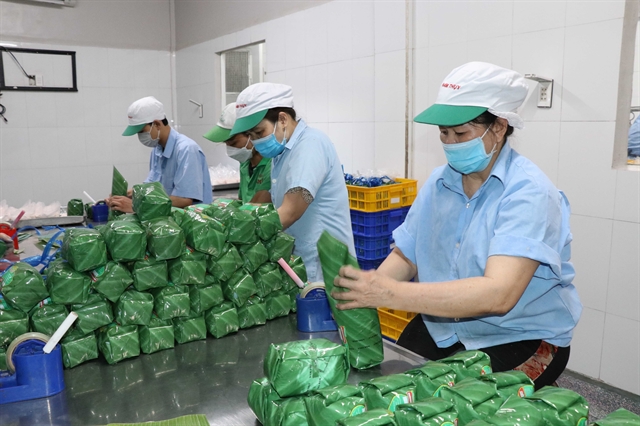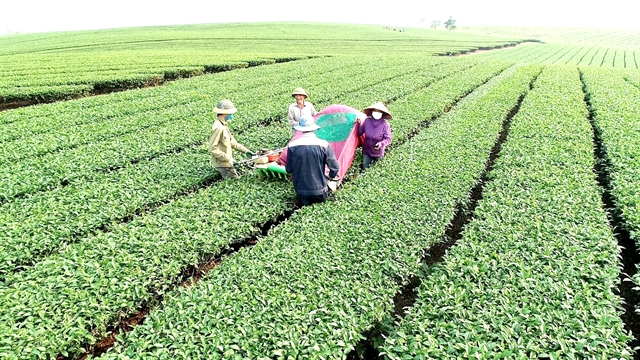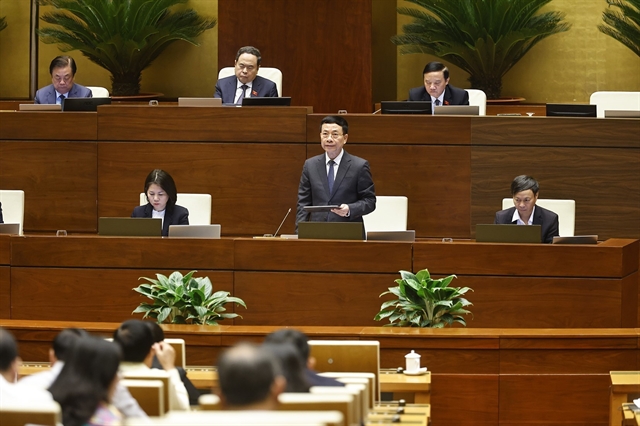 Society
Society

 |
| Farmers harvest tea in Mộc Châu District, Sơn La northern province. — VNA/VNS Photo Hồng Cường |
HÀ NỘI — Tea is an important crop for economic development in many localities across the country, and new tea varieties suitable for specific soil and climate regions have helped Việt Nam's tea not only concentrate in the north, but also expand in the central and Central Highlands regions.
Currently, the Tea Research and Development Centre (TRDC) under the Northern Mountainous Agriculture and Forestry Science Institute (NOMAFSI) is the only research and development agency working on new tea varieties in the country.
To date, the new tea varieties area has accounted for more than 60 per cent of the national tea area, mainly using varieties successfully bred by many generations of the NOMAFSI’s staff.
Expanding production
While Thái Nguyên Province is the centre of green tea, Phú Thọ Province can be considered the "cradle" of the tea industry and new tea varieties in the country.
Nguyễn Thị Hồng Lam, Deputy Director of the TRDC, said that Việt Nam had two indigenous tea varieties including Shan Tuyết tea and Trung Du tea.
Original Shan Tuyết tea is from ancient tea areas in high mountains such as Suối Giàng (Yên Bái); Cao Bồ, Thương Sơn, Hoàng Su Phì and Lũng Phìn (Hà Giang); and Tủa Chùa (Điện Biên).
Hundred-year-old Shan Tuyết tea forests still give products with many precious properties and are indispensable raw materials for clean tea manufacture with high added value.
The Trung Du tea variety is suitable for Việt Nam's soil and has high vitality.
The two tea varieties are often chosen as parents in cross-breeding combinations with high success rates.
The created hybrids have many valuable characteristics, becoming new tea varieties that gradually replace old ones with higher yield and productivity.
Thanks to this process, along with localities that have traditional strengths in tea, some other provinces such as Lai Châu, Lào Cai and Nghệ An have strongly expanded new planting areas.
The tea industry has opened up many job opportunities for people, improved their lives, helped eliminate poverty and contributed significantly to economic growth in many localities.
Việt Nam Tea Association statistics showed that the total value of tea products in 2022 was VNĐ12.6 trillion (US$512.5 million).
Of the total 194,000 tons of tea produced in 2022, tea exports were 146,000 tons, worth $237 million.
Tea consumed domestically was about 48,000 tons, worth about VNĐ7.5 trillion ($304.7 million).
On NOMAFSI’s campus, over 25ha are used for trial planting, perfecting farming processes, and building models of new varieties.
This reflects the important position of tea in the institute's research.
Introducing the LCT1 variety created from Cù Dề Phùng and Trung Du tea varieties, Lam said it was good for making traditional green tea.
After being processed, the tea buds have a beautiful appearance, a strong sweet aftertaste, and a fragrant aroma of green rice, so they are widely appreciated.
Most tea areas in Thái Nguyên Province are using new tea varieties to replace the original Trung Du.
No matter what land it is grown on, the tea product still retains the same rich taste as that grown in Thái Nguyên, especially in the spring crop.
Varieties originating from Shan Tuyết tea such as PH12, PH14 and TC4 are suitable for processing high-quality tea.
Along with good quality, the PH14 variety has high yields of 20-30 tons per hectare, so it has great potential for making commercial tea.
Many provinces such as Hà Giang, Tuyên Quang and Điện Biên have put it into mass production, building specialty and organic tea brands for the localities, said Lam.
Diversification
Thanks to good tea breeds, the structure of tea products has also changed greatly.
From having only two or three similar products, now Việt Nam has many types of tea such as black tea, fragrant green tea, oolong tea, Phổ Nhĩ tea and white tea, with values many times higher than traditional green tea.
In particular, the VN15 variety is very good and can be processed into a number of high-quality green tea products such as Mao Tiêm and Bích Loa Xuân.
The variety has been popular in Thái Nguyên, Phú Thọ and Sơn La. The NOMAFSI has also brought it to Kon Tum and Lâm Đồng provinces in the Central Highlands for experimental planting.
With increasing domestic and export market demand, the raw tea area expansion brings opportunities and diversifies crop structure for localities. Tea has become a crop to reduce poverty in a stable way for local people. — VNS




